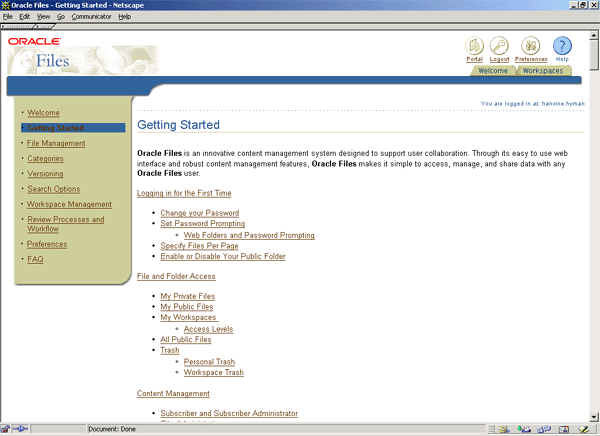| Oracle Files Administration Guide 9.0.3 Part Number A97358-01 |
|
| View PDF |
| Oracle Files Administration Guide 9.0.3 Part Number A97358-01 |
|
| View PDF |
Part of the Oracle Collaboration Suite, Oracle Files is a hosted content management application that supports user collaboration and file sharing. Oracle Files provides a sophisticated, Web-based user interface that enables users to easily share files of any kind with others in a workspace or across an enterprise.
Oracle Files runs with Oracle9i Application Server and an Oracle9i database. Oracle Files provides a highly scalable content management repository with a sophisticated Web-based user interface. This guide describes administration functions for Oracle Files.
This guide is for system administrators, site administrators, subscriber administrators, or anyone involved in configuring, running, and maintaining an Oracle Files instance.
Augmenting this Administration Guide is extensive online Help built into the Oracle Files user interface for end users and the Site Administrator and Subscriber Administrator. To access Help:
On any Oracle Files page, click the Help icon. A table of contents displays.

Text description of the illustration helppage.gif
Topics for administrators may only be viewed by logging in as an administrator.
Our goal is to make Oracle products, services, and supporting documentation accessible, with good usability, to the disabled community. To that end, our documentation includes features that make information available to users of assistive technology. This documentation is available in HTML format, and contains markup to facilitate access by the disabled community. Standards will continue to evolve over time, and Oracle Corporation is actively engaged with other market-leading technology vendors to address technical obstacles so that our documentation can be accessible to all of our customers. For additional information, visit the Oracle Accessibility Program Web site at http://www.oracle.com/accessibility/.
JAWS, a Windows screen reader, may not always correctly read the code examples in this document. The conventions for writing code require that closing braces should appear on an otherwise empty line; however, JAWS may not always read a line of text that consists solely of a bracket or brace.
This guide contains these chapters and appendices:
Chapter 1, "Oracle Files Concepts"
Introduces the components of Oracle Files, functions, and administration concepts and terminology.
Chapter 2, "Oracle Files Overview and Administration"
Describes the administrative roles, basic tasks, and how to use bulk administration tools. It shows how to specify access paths for the client software.
Chapter 3, "Administration Tools Overview"
Provides an overview of the tools provided to administer Oracle Files.
Chapter 4, "Basic Administrative Operations"
Covers runtime processes such as starting and stopping the domain controller, domains, and nodes. Shows how to monitor domain and node performance.
Chapter 5, "Maintenance and Tuning"
Discusses several methods for optimizing performance and scalability.
Chapter 6, "Oracle Internet Directory and Credential Management"
This chapter shows how to use the Oracle Files Credential Manager Configuration Assistant to create, edit, or delete credential managers.
Provides information for solving administrative and globalization problems.
Appendix A, "Oracle Text Reference"
Explains strategies for maintaining the Oracle Text index.
Appendix B, "Service Configuration Reference"
Describes the service configuration properties.
Appendix C, "Server Configuration Properties"
Describes the server configuration properties.
Appendix D, "Migrating Data to Oracle Files"
Steps through several data migration scenarios: server consolidation and migrating data between Oracle Files instances.
Appendix F, "FTP Quote Command Reference"
Provides a description, syntax, and example of each FTP Quote command.
Appendix E, "Oracle Files SQL View Reference"
Describes the Oracle Files Schema SQL Views.
Appendix G, "Globalization Support"
Contains information on globalization issues.
For more information, see the following manuals in theOracle Collaboration Suite, Oracle Files, Oracle9i Database Server, and Oracle9i Application Server documentation sets.
The following conventions are used in this manual:
| Convention | Description |
|---|---|
|
italic |
Italicized type identifies document titles. |
|
|
Monospace type indicates commands. |
|
bold |
Boldface type indicates script names, directory names, path names, and file names (for example, the root.sh script). |
|
UPPERCASE |
Uppercase letters indicate parameters or environment variables (for example, ORACLE_HOME). |
|
. |
In code examples, vertical ellipsis points indicate that information not directly related to the example has been omitted. |
|
. . . |
In command syntax, horizontal ellipsis points indicate repetition of the preceding parameters. The following command example indicates that more than one input_file may be specified on the command line.
|
|
< > |
In command syntax, angle brackets identify variables that the user must supply. You do not type the angle brackets. The following command example indicates that the user must enter a value for the variable input_file:
|
|
[ ] |
In command syntax, brackets enclose optional clauses from which you can choose one or none. You do not type the brackets. The following command example indicates that the variable output_file is optional:
|
|
{ } |
In command syntax, curly brackets indicate that a choice of two or more items separated by a vertical bar or pipe ( | ). You do not type the curly brackets. The following command example indicates a choice of either a or b:
|
|
$ |
The dollar sign represents the shell prompt in UNIX. Foot 1 |
| 1 In examples, an implied return occurs at the end of each line, unless otherwise noted. You must press the [Enter] key at the end of a line of input. |